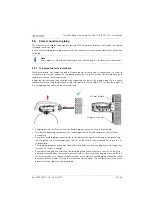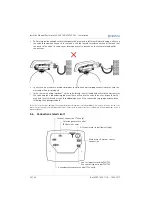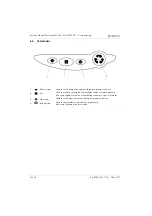
Installer Manual Performa 263-268 / LOGIX 740-760 - Installation
Ref. MKT-IM-011 / A - 15.06.2017
25 / 64
5.5.
Valve connection to piping
The connections should be hand tightened using PTFE (plumber’s tape) on the threads if using the
threaded connection type.
In case of heat welding (metal type connection), the connections should not be made to the valve when
soldering.
Note
See chapter 3.3. Description and components location, page 12 to identify the connections.
5.5.1. Top-mounted valve installation
When pressurized, any composite tank will expand both vertically and circumferential. In order to
compensate the vertical expansion, the piping connections to the valve must be flexible enough to
avoid overstress on the valve and tank.
In addition, the valve and tank should not be supporting any part of the piping weight. This is hence
compulsory to have the piping fixed to a rigid structure (e.g. frame, skid, wall…) so that the weight of
it is not applying any stress on the valve and tank.
•
The diagrams above illustrate how the flexible piping connection should be mounted.
•
In order to adequately compensate the tank elongation the flexible tubes must be installed
horizontally.
•
Should the flexible piping connection be installed in vertical position, instead of compensating
the elongation, it will create additional stresses on the valve & tank assembly. Therefore this is
to be avoided.
•
The flexible piping connection must be also be installed stretched, avoiding excessive length. For
instance 20 - 40 cm is enough.
•
Excessively long and non-stretched flexible piping connection will create stresses on the valve
and tank assembly when the system is pressurized, as illustrated in the below picture: on the left
the assembly when the system is unpressurised, on the right the flexible piping connection when
put under pressure tends to lift up the valve when stretching up. This configuration is even more
dramatic when using semi-flexible piping.
A
200 mm flexible
Support to the wall
















































